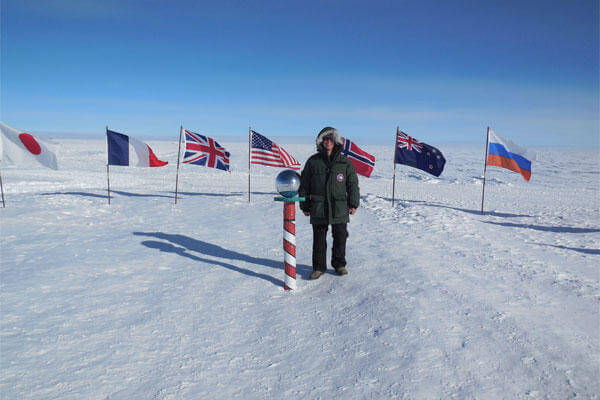U.S. AIR FORCE ACADEMY, Colo -- While most cadets traveled home for winter break, one meteorology major here headed as far south as you can go, to the coldest, windiest and driest place on earth -- Antarctica.
Last December, Cadet 1st Class Glen Hanson spent a week on the frozen continent (made up of nearly 98 percent solid ice) visiting the South Pole and observing climate, satellite, biological and astronomical research at McMurdo Station, the U.S. Antarctic science facility and the largest community on Antarctica.
"It was a 'once in a lifetime' opportunity," Hanson said. "I toured all the different research labs there. Scientists were conducting research on meteorology, marine biology, environmental astronomy and more. The atmosphere there is very transparent, making it a good spot for research. It provides a clearer view to spot lasers and satellites."
Hanson was allotted the trip through the National Science Foundation Service Academy Antarctic Internship. Since 2008, the Academy has sent a senior meteorology major to the isolated continent each year to interact with atmospheric and oceanographic researchers.
"It exposes earth science majors at U.S. service academies to unique research opportunities in the polar region, especially as is relates to climate change and impacts on national security," said Lt. Col. Christian Wohlwend, deputy head and assistant professor of physics and meteorology here. It also forces the cadets to learn to operate in a joint environment and with other government agencies."
Hanson traveled to Antarctica with a Navy midshipman to study oceanography. They spent the first few days in New Zealand due to technical difficulties with the Lockheed LC-130 that transported them to the South Pole.
"It's basically a C-130 on skis," Hanson said. "Due to the plane's malfunction, I was able to see some of New Zealand before heading down to the ice."
Hanson said a big incentive for the trip was to build connections between the Academy and the National Science Foundation.
"The foundation wants to get Antarctica on more people's radar," Hanson said. "They want the Air Force to understand their mission and it was a great opportunity for me to share the Academy's mission. It was an immersion. Most people there had never met an Air Force Academy cadet."
McMurdo Station is operated by the National Science Foundation and serves as a main operating base. Military personnel there help support the Antarctic Research program by flying and maintaining the aircraft that bring the community supplies and equipment.
"It's neat because these Airmen are operating in a deployed environment in Antarctica," Hanson said. "It's not combat but there are rigors with flying to the South Pole. They're operating dangerous flights due to the climate."
Hanson spent Christmas dinner with Airmen from the 109th New York Air National Guard. The Airmen spend half of the year in Antarctica and the other half in Greenland.
"We also had a gift exchange which was nice," Hanson said. "It's not a place for tourists. If you're there, you're either doing the actual mission or supporting it. Everyone is there for a purpose; Antarctica doesn't have any permanent residents."
Hanson said he saw penguins, killer whales, seals and large seagulls in Antarctica.
"There is some life there but not much" he said. "It's a strikingly beautiful place but pretty desolate. It's one thing to be able to go to Antarctica but then to also be able to see the South Pole is an incredible and unique experience."
Hanson said the South Pole's temperature was 25 below zero when he visited it.
"There is a separate outpost there," Hanson said. "There isn't a whole lot there. The majority of research conducted at the South Pole is space-based."
The seasons in Antarctica are opposite of the seasons in the Northern hemisphere. In the summer, there is light 24 hours a day.
"The sun never set when I was there which was weird but cool at the same time," Hanson said. "I was at McMurdo during the summer, when it's at sea level. I was actually walking around in jeans and a light jacket most of the time. The weather was nice and sunny, and I was able to go hiking."
Hanson said there were approximately 600 people at McMurdo during his trip. He said in the winter, personnel are reduced to about 50.
"In the winter, a few have to stay with the equipment and keep up with the research but there are less people because it's dark and the average temperature is negative 60 degrees," Hanson said.
Antarctica isn't all about climate change and penguins, Hanson said.
"Some of the research involves ice core drilling but most of it involves satellites, lasers, fancy imaging and using the ice as giant satellite," he said. "There is a lot of astrophysics work being done there."
Wohlwend said Hanson was selected for the internship based on his overall performance as a meteorology major, including a 3.9 grade point average, and his outstanding written proposal for the project.
"Experiential learning is one of the best ways to understand a topic and a great motivating factor for our students," Wohlwend said. "Most of the Academy's participants have competed well for a Master's degree program in science. They're also a unique part of our Science, Technology, Engineering, and Mathematics outreach program here at the Academy."
Hanson plans to attend graduate school at Penn State following graduation. He also plans to become an Air Force weather officer.
"The trip was good exposure for the field I want to go into," Hanson said. "Everyone checks the weather and likes to share stories on it. Meteorology has so many applications to it, whether it's for military, operations in general or operations in Antarctica. It's a science you actually get to see at work every day. I'd like to look into the interrelations of weather and how it impacts everything from threats and conflicts in a region to economic prosperity."






























